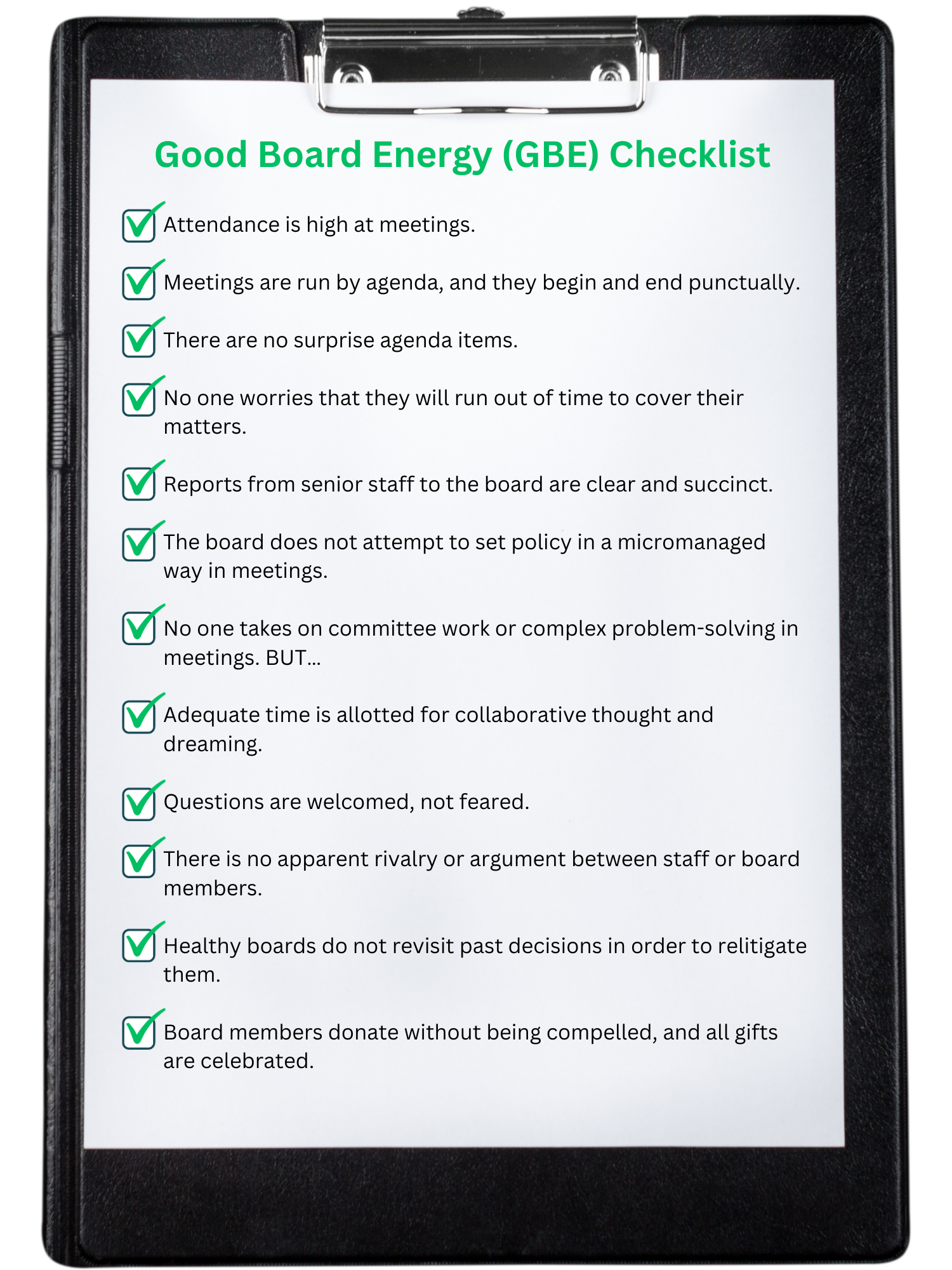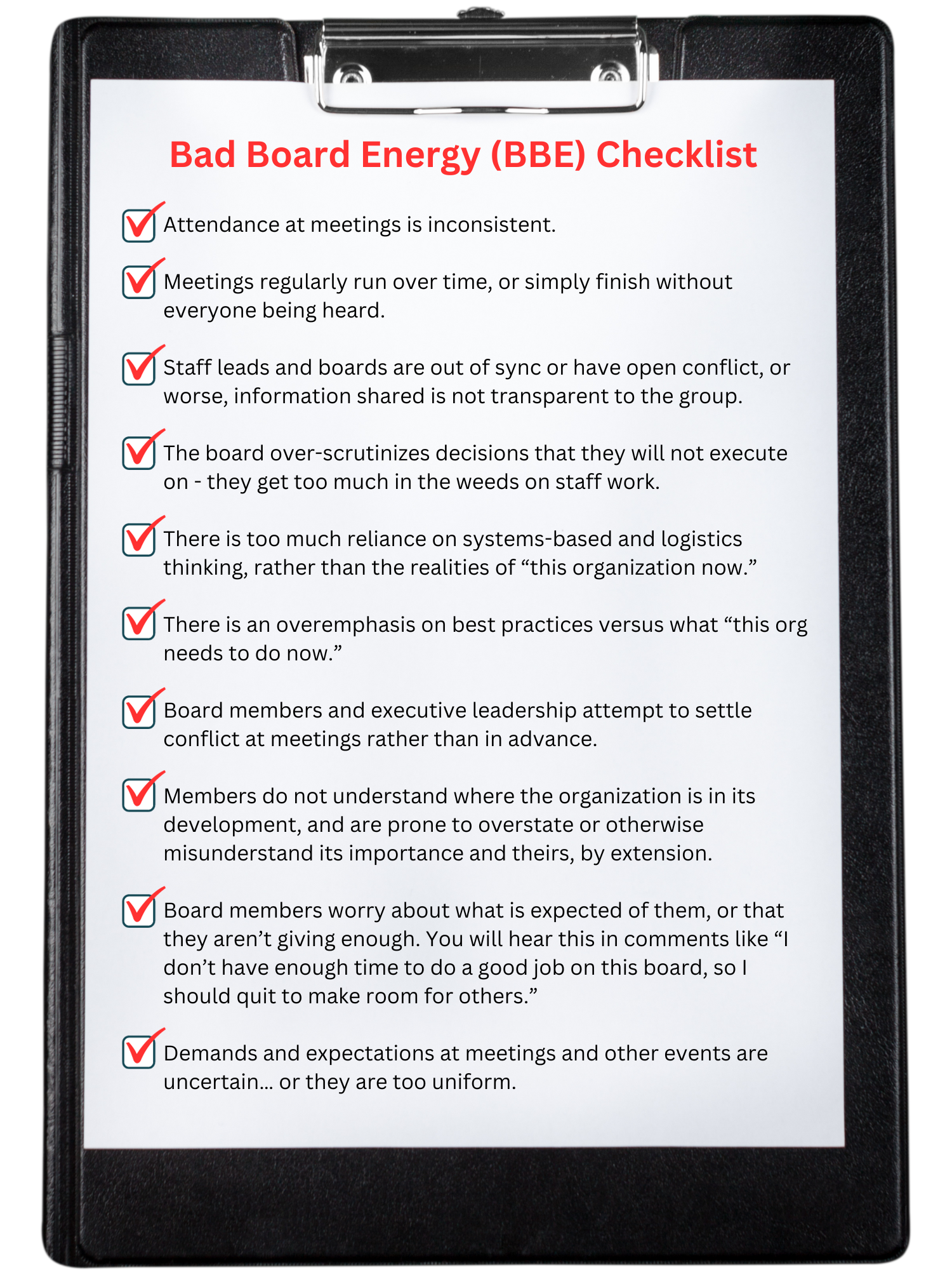- Josef Krebs
- Board Development
Reading Time: 5 minutes
Good Board Energy Versus Bad Board Energy: The Laundry Lists
The most frequent reason for folks to contact me, after “we need more money,” is issues with their boards. I’ve served on ten boards, have worked with several dozens, and have seen the great things a great board can accomplish and the horrible things a bad board can do.
There’s a line in Tolstoy I am reminded of every time I work with a board: “Happy families are all alike; every unhappy family is unhappy in its own way.” Now, I *loathe* talking about nonprofits in terms of family, but generally I do think Tolstoy is onto something here about boards.
Let’s talk about good board energy versus bad board energy in broad terms.
Ideally, everyone associated with a nonprofit will operate with compassionate motivation toward achieving a shared mission – from the staff to the executive leadership to the board. In short, they will be working with love for the internal team and the external community served by the nonprofit. The ultimate currency in nonprofit work is love. Not money, not coolness. Love.
But even when there is love, conflict is inevitable, and when roles are poorly defined and respect is not maintained, conflict can overwhelm even the best intentions.
Everyone plays a role in keeping energy good and holding themselves accountable, but it’s essential for the executive director and board chairs to understand these principles.
And that’s concept number one: The relationship between Executive Director (or other chief staff officer) and Board President (or chair or other chief board officer) is the central one to any nonprofit. That relationship is the absolute key to success or failure.
Good board management principles are about how we show love and grow love through gratitude, humility and respect. The contrast of good board energy and bad board energy is just one lens on these dynamics that show up in our families, businesses, and communities. Strategies for mitigating bad board energy and cultivating good board energy are directed toward those in leadership roles, but the big lessons here are universal.
You Might Have Bad Board Energy When…
-
- Board meetings are poorly attended, do not have clear agendas, or run over time – they are bad meetings.
- Staff members are frequently afraid of or skeptical of board members.
- Executive directors often berate the board for not fulfilling their duties or raising enough money.
- Board members are dismissive of staff members.
This last one is particularly true of boards dominated by highly corporate members. There is a tendency to look down on nonprofit work and management techniques from the corporate world. Literally yesterday a banker told me, “nonprofits need help to run more like businesses.” I’ll say it plainly: This is utterly oblivious. First of all, obviously, nonprofits *are* businesses, so no matter how they run, they run like businesses. But even more importantly, nonprofits are much harder to manage than for-profits, because there are so many more political dynamics at play. Confidential to corporate executives who think they know better: You can learn a lot from great nonprofit executives, and you should. Don’t condescend to them, ever.
So What Is Good Board Energy?
You may notice that I like to compare and contrast a lot in these posts. Below, I’ve written out a list of traits you expect to see in good board energy and a list of signs of bad board energy.
These lists aren’t mirror images, and when I go into greater detail about good board energy in another blog, I focus on reminders of how to create and maintain good structures and dynamics. When I focus on bad board energy, the strategies are about what to avoid in the first place.
At its core, good board energy is an obvious reflection of a genuine, collaborative commitment to the mission. The board is a deferential partner to executive leadership, and treats the staff as professionals from whom they learn. They work to get what staff members need to succeed, and they in turn feel appreciated for their contributions, insights, talents.
Moving past warm, fuzzy generalities, here are some ways that Good Board Energy manifests in action.

By contrast, here are some warning signs…

It takes time to cultivate good board energy, so the earlier you start, the better. Meanwhile, bad board energy can bring down organizations very quickly, but must be addressed strategically and delicately. An ounce of prevention is worth a ton of cure when it comes to working with nonprofit boards.
We will revisit and expand on these ideas in future posts. Until then, remember that the lists above are just laundry lists to get you thinking about the kind of board energy you have. In most nonprofits, you’ll have a mixture, and both good and bad energies have feedback loops. Here’s an easy rule:
Identify and nurture good board energy, and don’t give bad energy a chance to grow.
Never Miss A Blog!
Subscribe for free and get every new post sent straight to your inbox (about twice per month).
By submitting this form, you are consenting to receive marketing emails from: . You can revoke your consent to receive emails at any time by using the SafeUnsubscribe® link, found at the bottom of every email. Emails are serviced by Constant Contact


